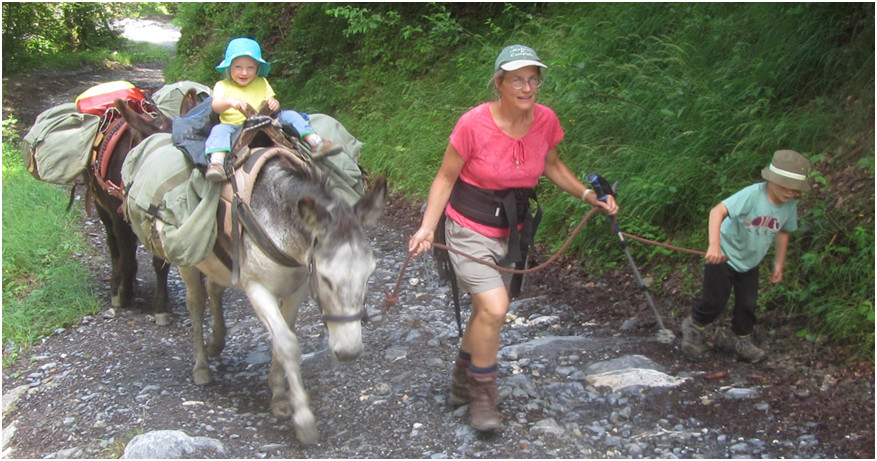
A donkey trek in the Haute Giffre
Mark and Julie McLean, summer 2016
A donkey trek of a few hours in Portugal gave us the germ of a plan to go backpacking with our children. Rosie is two and fairly easily carried, Ian is five and rather heavy, but not yet able to walk all that fast. With camping gear and a few days food it would be completely impossible to carry it all.
So we searched for a donkey trekking outfit in a nice sounding area. Initially I was keen on the Ariege in the Pyrenees, but the company there flatly refused to allow us take our young children into the mountains with their donkeys. What our children had to do with them I don't know, but when people stop replying to your emails, there isn't much you can do.
So we settled on the Haute Giffre, just to the west of the Aguilles Rouge. Jeremy answered all my questions (helpfully translated by Google) and suggested a route for six nights in the mountains. One donkey would carry Ian, the other would carry our food and some gear, and I would have a large rucsac too. In fact we finished up with some donkey panniers of light stuff on Ian's donkey too. We could have stayed in huts, except the Tourist Information leaflet said that they didn't take children younger than three. This was not in fact true, but with donkeys to carry the gear there was no need to stay in the huts, and camping was more flexible and of course a lot cheaper.
So one sunny morning we met Jeremy in person near Sixt Fer De Cheval and unloaded our heaps of gear and food into a large pile which we then packed into donkey panniers. Jeremy was happy for each donkey to carry 40kg of our stuff, even one that was encumbered by a terribly heavy saddle. There was no donkey food to carry, he said they would be fine grazing at night, and that they scarcely needed to drink. In the end we put about 34kg on one donkey and just 10kg on the other, which would also carry Ian who weighs 20kg. There was also a bag with steel stakes, ropes, brushes and donkey insect repellent, but that didn't count towards the payload weight either. Julie insisted that we also take a bag of carrots as donkey treats. The larger donkey with the heavy saddle was called Maya, and the other was Kalimero.

The first day was up a straightforward four wheel drive track. This was a great place to experiment with which donkey should lead, which was best for Ian to ride, and how to chain the two donkeys together to save us both having to lead one. Chaining them with the more willing Kali in front was a great help because then it was Kali, not me, who had to give Maya a tug each time she stopped. We did have one scary moment when we met a rumbling scary digger coming down the track, donkeys went in both directions and Ian, who was walking at the time, climbed 6 foot up the side of the track to get out of the way. Just at that moment some hikers with a dog arrived to further spook the donkeys, but no harm was done.
After a few hours walking and a couple of picnic stops we came to the Refuge de Fonts, near which we made our “bivouac” (camping is forbidden in the park, but an overnight camp is permitted). The hut guardian said we could use the hut's donkey enclosure and even suggested we made a fire. Getting the donkeys to walk past the hut was a struggle, they wanted to go directly to the donkey enclosure, but we managed with some helping prods from bystanders. Then we made camp where the guardian had suggested, unloaded the donkeys and took them back to the enclosure. We didn't get to make a fire because it started to rain, and we retired to the tent. We'd climbed about 600m, Ian had ridden much of the way, and everything was going well.
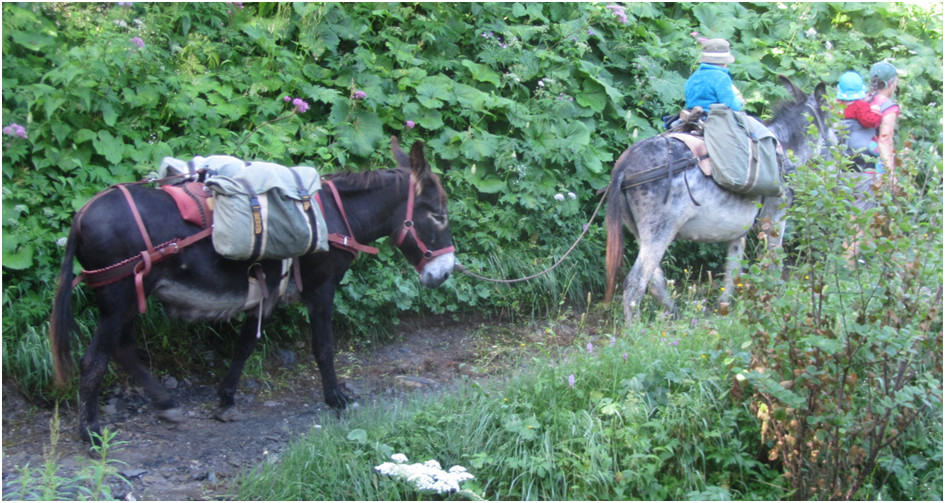
Next morning we had to catch the donkeys and bring them back to the tent without allowing a third donkey in the enclosure to escape. This was actually very easy, the donkeys did not try to evade capture and were very happy to be rewarded with a carrot each. We saddled the donkeys, struck camp and continued on our way. The weather was clear and sunny and the only thing dampening or mood was that Ian seemed unusually tired. After an hour or so we had to make a decision, there was a considerably longer and more up-and-down route, or a shorter route that crossed a couple of snow patches. After some dithering we decided to try the snow. Kalimero was not keen, but we discovered that Maya was more willing and that once she was across Kalimero would follow. Now we began to suffer from a problem that would dog the whole trip: if the donkeys needed both of us (for example if the ground was too rough to have the donkeys tied together), there was no-one for Ian. He waited quite happily on this occasion and was never out of sight, but this wasn't always true.
Anyway, we got across the snow patches and made camp a couple of hours later near Lac d’Anterne, with marmots calling and our first dry evening. There was a snow bank near the tent and Ian and Rosie had a lovely time collecting ice and playing by a stream. Later though Ian flaked out, didn't want his food and developed a temperature, something was clearly amiss.
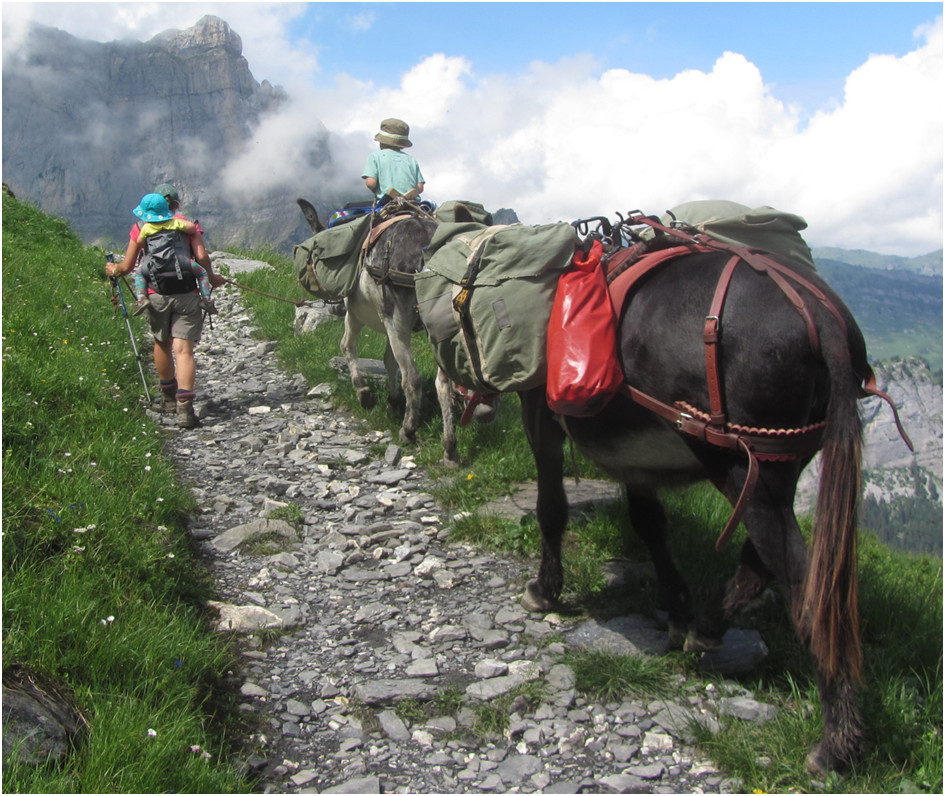
In the morning Ian was quite unwell. After we'd had breakfast (which Ian wouldn't eat) and packed up, Juliette set off with both donkeys in tandem (the back donkey tied by its halter to the back of the saddle of the leader) and Ian riding the leader, but hadn't gone far when the leader made a small jump and Ian fell off. It was at least partly because he wasn't holding on properly, but of course it made him nervous of riding. That day we climbed over our highest pass and were rewarded by a glorious view of the Mont Blanc massif. On the way up we had to cross some snow patches and had the problem of having to leave Ian alone while we handled the donkeys. But the way down was worse because it was so steep that we had to lead the donkeys individually and ask Ian to follow us down, which he just wasn't really capable of. He kept stopping or going the wrong way or getting upset, which is fair enough considering he was only five.
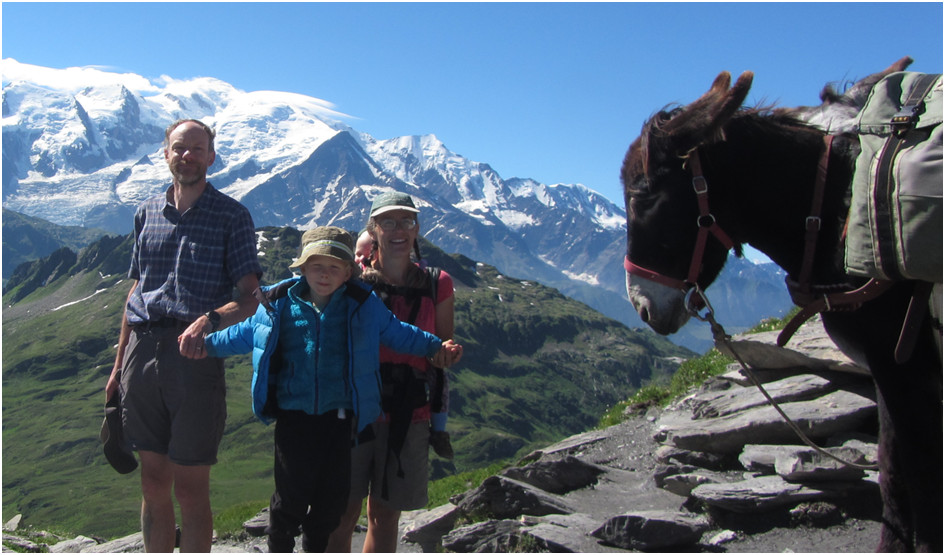
The refuge at the bottom of the pass had a vehicle track up to it and we seriously considered abandoning the trip. Instead we fed Ian some Paracetamol and went on for another half hour to the most beautiful lake (Lac de Pormenaz), which we camped beside. Ian perked up a bit and he and Rosie caught small fish in a stream by simply scooping them out with a Trangia pan, that's how dense the shoal was! That night we all woke up for a wee around midnight and the stars were some of the clearest I've ever seen.
Next day walking past the lake I was leading both donkeys and carelessly led them across a small innocuous looking pool. Although only about a foot wide, it was deep, and the second donkey (Maya) fell in with her front legs and got stuck. The donkeys were tied together so this pulled off Kalimero’s saddle. Happily, once we'd untangled the mess Maya was able to climb out, and we were relieved to find that she was unhurt.
Then we had to climb back over the previous day's pass. This time we put my rucsac on Maya and improvised a child sling so I could carry Ian. Although heavy, it meant we could stay together and worked quite well. We walked past the lakeside campsite of two nights before and on to the Alfred Wills refuge where we camped. We had a bowl of hot chocolate in the hut and met a German family doing a similar trek with one donkey and a three year old girl, Theresa. They were staying in the huts which meant they didn't need the second donkey. The three children played together oblivious to the language barrier.
We initially planned to camp by some trees a little way away from the hut, but it meant walking past the donkey enclosure and the donkeys really didn't want to do that. So instead we camped in a somewhat exposed location slightly above the hut and then turned the donkeys out into their field, along with “Basil” our new friends’ donkey. As evening approached another six or so tents popped up around ours, which was a little surprising because the forecast wasn't very good.
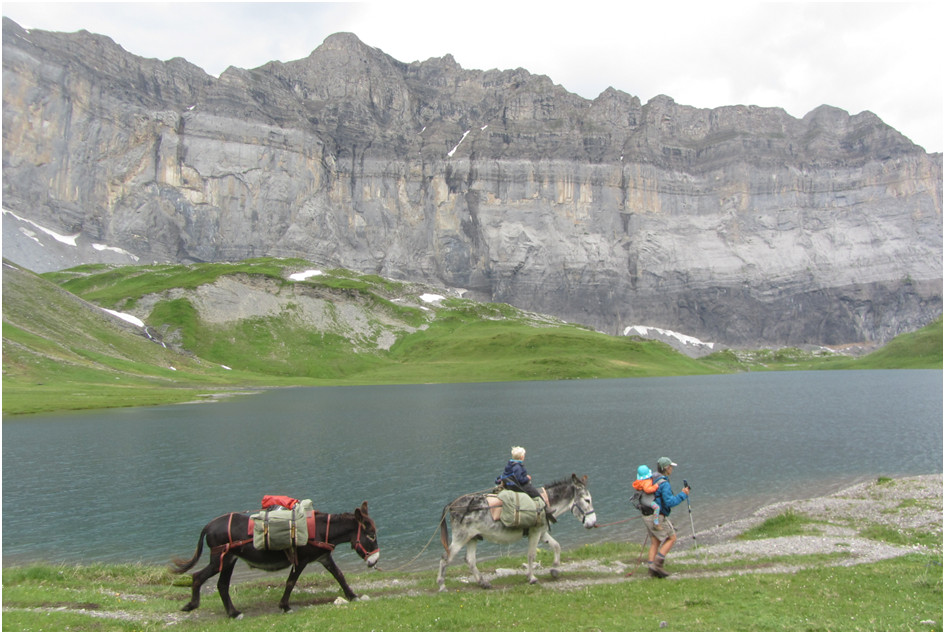
In fact it was a pretty terrible night, heavy rain, strong winds and thunder rolling around. The tent was lashed and pushed about a fair bit, but it held. In the morning it was still raining and pushing the tent around, but happily by the time we'd had breakfast and got packed up, it had largely stopped raining. There was a lot going on around the Refuge, and we soon gathered that a fell race was happening that day. We met the leading runners a little later, after we'd walked about a kilometre. Soon after we came to a bridge, which Kalimero staunchly refused to cross. Even after Maya had crossed, Kalimero still wouldn't budge, and the situation was not helped by more runners, keen not to lose time, crossing the bridge and alarming Kalimero. The gaps between the runners became shorter, so we decided to try the alternative: fording the river. I took off my socks and laced my boots up tight and led him into the river where it seemed most shallow. Kalimero was fairly happy to follow me, and we splashed our way across.
The next section of the trek which actually pretty difficult. The path was narrow, steep and slippery from the night's rain, and there was a constant stream of hurrying runners coming the other way. We had to lead the donkeys separately and constantly chivvy Ian to keep going, while also dealing with the narrow path and the runners trying to get past. It was a great relief when we reached a junction and turned back uphill on a much quieter path. The rest of the day was wonderful as we walked up a wooded valley past a series of waterfalls.
That night we stayed at the Refuge de Sales, we'd planned to stay in the refuge that night as we thought we might appreciate a night indoors, and it proved to be a lucky choice because the weather turned very wet again, so it was great to be inside eating fondue with a dry bed to go to. Ian was much more himself now and enjoyed playing with Theresa, meanwhile I had caught his lurgy and went to bed early with a temperature.
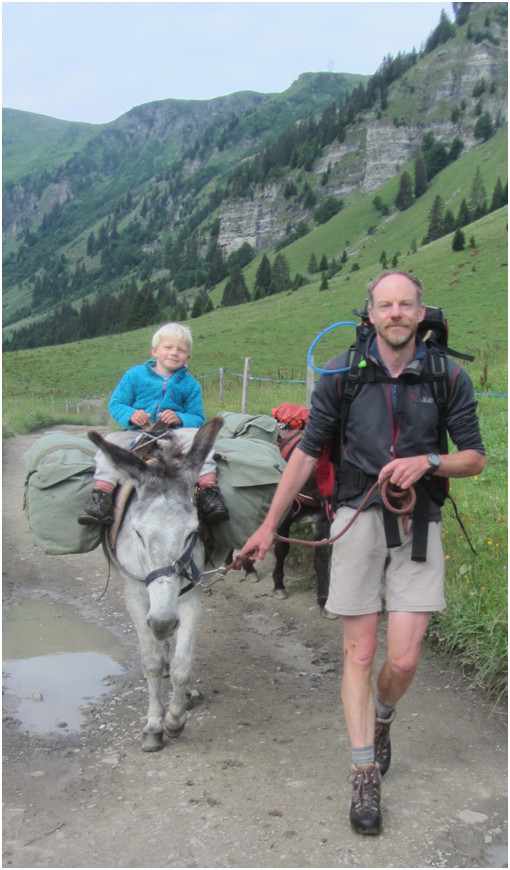 The following day dawned cloudy but dry. We had decided to try walking with Basil the donkey, Theresa and her parents. The path was the least distinct of the whole trip, but recently repainted with reasonably frequent red spots after another party had lost the way. We had a prolonged lunch stop while the children played on a snow patch, and then some faffing because there was a very short section where the rocks beside the path meant the donkeys had to be unloaded to pass through a narrow gap.
The following day dawned cloudy but dry. We had decided to try walking with Basil the donkey, Theresa and her parents. The path was the least distinct of the whole trip, but recently repainted with reasonably frequent red spots after another party had lost the way. We had a prolonged lunch stop while the children played on a snow patch, and then some faffing because there was a very short section where the rocks beside the path meant the donkeys had to be unloaded to pass through a narrow gap.
An hour or so later we were walking happily down a broad track, with Julie leading both donkeys and Ian riding on Kalimero. They came to a dead sheep on the track, and both donkeys stopped to sniff it and didn't want to go on. We were just considering what to do, and about to get Ian down and separate the donkeys, when Kalimero reared up, threw Ian, and bolted. Ian was OK, but Julie tried to hold Kalimero and got knocked down, and I grabbed the rope between the donkeys and got pulled over and briefly dragged down the track. I let go and the donkeys careered off down the hill. We picked ourselves up and established that no one was seriously hurt and then I followed the donkeys and eventually caught them. Ian was understandable upset but unhurt apart from a few bruises, I had some cuts and bruises, and Julie had what we thought was probably a sprained thumb. The thumb meant that Julie couldn't lead the donkeys, but fortunately the rest of that day was easy tracks, and the German couple with Basil helped us out by leading one of the donkeys some of the time. That night we made our “bivouac” by the Chalet du Lac de Gers. It was a bit of a struggle to put up the tent, Julie with one hand and me unable to squat or kneel due to the bruises. Julie had a good study of the map and with help from our poly-lingual German friends we rang Jeremy (the donkey owner) and asked to be collected from a road-head quite high in the mountains that we could access by a reasonably flat and easy track.
The next day worked out fine. The track down was easy and the weather was fine. Ian even rode the donkey a little way. Jeremy's colleague arrived at the road-head with a horse box and Julie and the children said goodbye to the donkeys. He took the donkeys and I back to where we'd started the trek and left our car. Then I drove back and collected Julie and the children. That afternoon we visited a clinic in a nearby town where Julie's hand was x-rayed and scanned with ultrasound to reveal a broken ligament, it was operated on a few days later and is healing well. The children really loved the donkeys and are still talking about them now.
What would we do differently if we did another donkey trek?